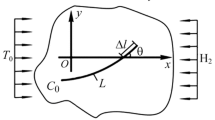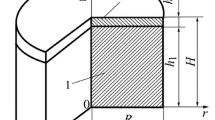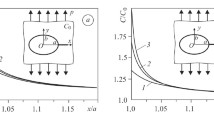We proposed a computational model for the determination of the kinetics of propagation of hydrogen cracks in a body caused by high pressures in these cracks formed due to ultrahigh hydrogen concentrations in the body. The model is based on the deformation criterion of fracture mechanics with regard for the hydrogen concentration, the mechanism of jumplike propagation of hydrogen cracks, and the Fick laws of heat and mass transfer. Using this model, we investigate the kinetics of propagation of a hydrogen crack over the surface of fusion of the base materia with protective coating in the shell of an oilhydrocracking reactor.





Similar content being viewed by others
References
Yu. Murakami, “Effect of hydrogen on fatigue crack growth in metals,” in: Proc. of the 17th Europ. Conf. on Fracture, ECF-17: “Multilevel Approach to Fracture of Materials, Components and Structures” (Brno, Czech Republic), CD ROM (2008), pp. 25−42.
O. E. Andreikiv and O. V. Hembara, Fracture Mechanics and Durability of Metallic Materials in Hydrogen-Containing Media [in Ukrainian], Naukova Dumka, Kyiv (2007).
O. E. Andreikiv, H. M. Nykyforchyn, and V. I. Tkachov, “Strength and fracture of metallic materials and structural elements in hydrogen-containing media,” in: V. V. Panasyuk (editor), Physicomechanical Institute: Advances and Achievements [in Ukrainian], Karpenko Physicomechanical Institute, Ukrainian National Academy of Sciences, Lviv (2001), pp. 248–286.
O. E. Andreikiv, “Durability of metallic materials in hydrogen-containing media,” Progr. Mater. Technol., No. 2, 423–439 (2003).
O. E. Andreikiv, V. R. Skal’s’kyi, and O. V. Hembara, “A method of estimating the high-temperature hydrogen fracture of bimetallic structural elements,” Fiz.-Khim. Mekh. Mater., No. 4, 15– 23 (1980).
V. V. Panasyuk, O. Ye. Andreykiv, O. I. Darchuk, and N. V. Kuznyak, “Influence of hydrogen-containing environments on fatigue crack extension resistance of metals,” in: Handbook of Fracture Crack Propagation in Metallic Structures, Vol. 2, Elsevier, Amsterdam (1994), pp. 1205–1242.
V. V. Panasyuk, O. Ye. Andreykiv, and O. V. Gembara, “Hydrogen degradation of materials under long-term operation of technological equipment,” Int. J. Hydrogen Energy, No. 25, 67–74 (2000).
V. V. Panasyuk, A. E. Andreikiv, and V. Z. Parton, Foundations of Fracture Mechanics [in Russian], Naukova Dumka, Kiev (1988).
Yu. V. Banakhevych, O. V. Hembara, and O. E. Andreikiv, “Calculation of the kinetics of propagation of hydrogen blisters in oiland-gas equipment,” Fiz.-Khim. Mekh. Mater., 45, No. 5, 17–25 (2009); English translation: Mater. Sci., 45, No. 5, 17–25 (2009).
M. V. Lysak and V. R. Skal’s’kyi, “Effect of the cooling rate of materials of an oil-hydrocracking reactor on crack initiation,” Fiz.-Khim. Mekh. Mater., No. 6, 105–107 (1993).
V. R. Skal’s’kyi, O. E. Andreikiv, and O. M. Serhienko, “Assessment of the hydrogen damage to materials by the amplitudes of acoustic-emission signals,” Tekh. Diagnost. Neruin. Kontr., No. 1, 17–27 (1999).
A. E. Andreikiv, N. V. Lysak, V. R. Skal’skii, et al., “Hydrogen cracking of metals and alloys and its acoustic-emission control,” Fiz.-Khim. Mekh. Mater., No. 4, 63–69 (1992).
V. R. Skal’skii, “Effect of hydrogen on the cracking of metals and monitoring of these processes by the acoustic-emission method,” Tekh. Diagnost. Nerazrush. Kontr., No. 1, 52–65 (1995).
A. E. Andreikiv and N. V. Lysak, Acoustic-Emission Method in the Investigation of Fracture Processes [in Russian], Naukova Dumka, Kiev (1980).
Author information
Authors and Affiliations
Corresponding author
Additional information
Translated from Fizyko-Khimichna Mekhanika Materialiv, Vol. 51, No. 1, pp. 71–79, January–February, 2015.
Rights and permissions
About this article
Cite this article
Andreikiv, O.E., Dobrovol’s’ka, L.N. & Yavors’ka, N.V. Computational Model of Crack Propagation in Bimetallic Materials for High Concentrations of Hydrogen and High Temperatures. Mater Sci 51, 76–87 (2015). https://doi.org/10.1007/s11003-015-9812-1
Received:
Published:
Issue Date:
DOI: https://doi.org/10.1007/s11003-015-9812-1




